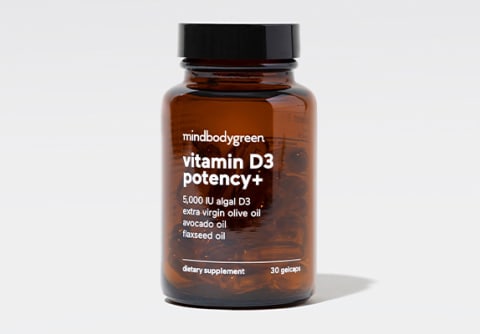Advertisement
How To Reach (& Maintain) Sufficient Vitamin D Levels, From Experts


Ashley Jordan Ferira, Ph.D., RDN is Vice President of Scientific Affairs at mindbodygreen. She received her bachelor's degree in Biological Basis of Behavior from the University of Pennsylvania and Ph.D. in Foods and Nutrition from the University of Georgia.

When it comes to discussing the vitamin D nutrient gap, we don't shy away from the opportunity to share our point of view—in fact, we're pretty proud to get on our soapbox about it. Why, you ask? One moment, let me grab my megaphone…
Between 93%1 and 100% of the U.S. population2 is failing to consume the vitamin D they need from diet alone—that's pretty much all of us! To get more specific and consider diet, sunshine, and all the inputs: 41% of American adults are clinically insufficient in vitamin D, and 29% are straight-up deficient3.
At mbg, we care deeply about this issue, and our content reflects that. We've covered signs you're deficient in vitamin D yourself, as well as strategies to raise those pesky vitamin D levels, and everything in between.
We know vitamin D levels can be challenging to maintain, to say the least. But once you reach the coveted vitamin D sufficiency status, what comes next?
The 411 on vitamin D levels.
Let's start off with a quick recap on vitamin D levels. Doctors and researchers determine vitamin D levels in the body by performing a blood test to measure your serum total 25-hydroxyvitamin D, or 25(OH)D for short. This is the most accurate way to measure your vitamin D status.
Ashley Jordan Ferira, Ph.D., RDN, mbg's director of scientific affairs, discusses the significance of testing for optimal vitamin D levels here. She explains, "Your 25(OH)D level is a biomarker that reflects your whole-body vitamin D status from circulating blood levels. Vitamin D is the starting vitamin input, and that essential micronutrient is hydroxylated in your liver to 25(OH)D to travel around the body, available to your various organs for a variety of critical health functions."*
The goal for vitamin D sufficiency.
When your blood work test results come back, you'll see your 25(OH)D measurement quantified in nanograms per milliliter (ng/ml). From a clinical perspective, the ranges go something like this:
- Anything below 20 ng/ml is considered vitamin D deficiency.
- 20 ng/ml to 30 ng/ml is considered vitamin D insufficiency.
- Anything above 30 ng/ml is considered "sufficient."
Here's the issue with those ranges: As the bottom cutoff for sufficiency, 30 ng/ml is a far cry from ideal vitamin D levels.
And considering vitamin D receptors are found in nearly every cell in the body (indicating vitamin D plays an important role in virtually every physiological system), having optimal levels of D is absolutely vital to your whole-body health.*
That's why many trusted nutrition and medical experts have adopted 50 ng/ml as the new standard goal for optimal vitamin D levels—including our very own Ferira, who deems 30 ng/ml the warning zone you "avoid with intention," not a number to strive for. Ferira shares this analogy: "If you want an "A" grade on a test and the cutoff for that achievement is 90, you don't aim for 89 or 90, you aim higher."
Getting enough vitamin D daily is not an easy "A", though. Truthfully, it's ridiculously difficult—OK, just about impossible—to get enough vitamin D from food and sunshine alone. (This is where supplementation comes in.)
Achieving vitamin D sufficiency through supplementation.
If your vitamin D levels are currently below 50 ng/ml and you'd like to take action to achieve true vitamin D sufficiency, here are some tips to get you there:
- Choose a vitamin D3 supplement for its superior bioavailability. When the question is D2 (ergocalciferol) versus D3 (cholecalciferol), D3 wins every time.*
- Make sure you're getting enough magnesium. Vitamin D needs ample magnesium to be properly absorbed. If you're struggling to raise your vitamin D status, testing your magnesium levels might be warranted.
- Take your vitamin D with a healthy fat to optimize absorption. Fun fact: Vitamin D absorbs 32% better4 when accompanied by a source of fat.* So we're not saying you have to take your D supplement with avocado toast every morning, but it sure would help.
Let's say you get your 25(OH)D levels tested and it turns out your status is 31 ng/ml. You're not sure what that means, so you do some research and discover you're just on the cusp of insufficiency—oh no!
You decide it's time to distance yourself from the warning zone, so you follow all the advice in this article and start taking a daily high-quality vitamin D3 supplement with 5,000 IU (a clinically effective dose rooted in research) and built-in fat absorption technology (like mindbodygreen's vitamin D3 potency+).
And who could forget about magnesium? You make sure you get enough of the essential mineral in your diet by adding enough magnesium-rich foods like chia seeds, almonds, and walnuts to your meals (and a high-quality supplement can help too) to reach the recommended daily allowance (310 to 320 milligrams for women and 410 to 420 milligrams for men).
You even try to get outside on sunny days and eat foods rich in vitamin D (e.g., salmon, tuna, egg yolks, and mushrooms) a few times a week. There's no doubt you've covered all your bases.
You follow this routine diligently for three months and get your vitamin D levels retested. You get your results back and—you did it! You reached that coveted 50 ng/ml (on the nose, in fact).
But now what?
What to do once you reach 50 ng/ml.
You're in a great position now—50 ng/ml is far from insufficiency and certainly high enough for you to reap the full spectrum of vitamin D whole-body health benefits.* You can also raise your 25(OH)D status by quite a lot before reaching truly toxic levels of vitamin D.* (But we'll let the science do the talking, here.)
It was reported in a 2018 review published in 5Frontiers in Endocrinology5 that both the Institute of Medicine and the Endocrine Society have concluded serum 25(OH)D concentrations must exceed 150 ng/ml for vitamin D toxicity to be of concern. If you haven't done the mental math already, that's three times the recommended 25(OH)D level of 50 ng/ml.
Now that we've addressed any apprehension you may have about climbing above 50 ng/ml, let's talk about next steps for maintaining sufficient vitamin D levels. After taking a high-potency D3 supplement for the past three months, what you don't want to do is stop cold turkey after reaching 50 ng/ml. This will surely lead to yo-yo-ing between sufficient and insufficient D status, and we're exclusively aiming for steady levels of vitamin D sufficiency.
Some nutrition experts and clinicians recommend their patients hover around 50 ng/ml, while others encourage their patients to aim higher (we’re talking 60 to 80 ng/ml). We encourage you to find an endocrinologist, registered dietitian, or other health care practitioner well-versed in the current vitamin D research and best practices to care for you and your specific health needs.
Whether you and your trusted care provider decide you should continue taking 5,000 IU of vitamin D each day, more than 5,000 IU, or cut back to a lower dosage (e.g., 2,000 to 3,000 IU), it's important to continue testing your 25(OH)D levels periodically to establish a supplementation routine that works for your personal biological makeup.
The takeaway.
While vitamin D insufficiency and deficiency are extremely common in the U.S., people's vitamin D needs are unique, and their approach to achieving optimal levels should be individualized.
Talk to your health care provider to create a game plan for reaching sufficient vitamin D levels—and maintaining them once you get there. Additionally, you should get your 25(OH)D levels tested regularly (at least once a year) to confirm you're successfully avoiding the warning zone and cruising along in sweet, sweet vitamin D sufficiency.
If you are pregnant, breastfeeding, or taking medications, consult with your doctor before starting a supplement routine. It is always optimal to consult with a health care provider when considering what supplements are right for you.
5 Sources
- https://www.ncbi.nlm.nih.gov/labs/pmc/articles/PMC5579642/
- https://www.ncbi.nlm.nih.gov/labs/pmc/articles/PMC3174857/
- https://www.cambridge.org/core/journals/british-journal-of-nutrition/article/vitamin-d-deficiency-and-insufficiency-among-us-adults-prevalence-predictors-and-clinical-implications/44E436843510FE6BDE856D5BCB9C651F
- https://pubmed.ncbi.nlm.nih.gov/25441954/
- https://www.frontiersin.org/articles/10.3389/fendo.2018.00550/full
Watch Next
Enjoy some of our favorite clips from classes
Enjoy some of our favorite clips from classes
What Is Meditation?
Mindfulness/Spirituality | Light Watkins
Box Breathing
Mindfulness/Spirituality | Gwen Dittmar
What Breathwork Can Address
Mindfulness/Spirituality | Gwen Dittmar
The 8 Limbs of Yoga - What is Asana?
Yoga | Caley Alyssa
Two Standing Postures to Open Up Tight Hips
Yoga | Caley Alyssa
How Plants Can Optimize Athletic Performance
Nutrition | Rich Roll
What to Eat Before a Workout
Nutrition | Rich Roll
How Ayurveda Helps Us Navigate Modern Life
Nutrition | Sahara Rose
Messages About Love & Relationships
Love & Relationships | Esther Perel
Love Languages
Love & Relationships | Esther Perel
What Is Meditation?
Box Breathing
What Breathwork Can Address
The 8 Limbs of Yoga - What is Asana?
Two Standing Postures to Open Up Tight Hips
How Plants Can Optimize Athletic Performance
What to Eat Before a Workout
How Ayurveda Helps Us Navigate Modern Life
Messages About Love & Relationships
Love Languages
Advertisement

Want To Be Metabolically Healthy? New Study Shows An Underutilized Approach
Molly Knudsen, M.S., RDN

Bounce Back Quickly After Workouts With This DIY Electrolyte Drink
Molly Knudsen, M.S., RDN

Want To Be Metabolically Healthy? New Study Shows An Underutilized Approach
Molly Knudsen, M.S., RDN

Bounce Back Quickly After Workouts With This DIY Electrolyte Drink
Molly Knudsen, M.S., RDN














